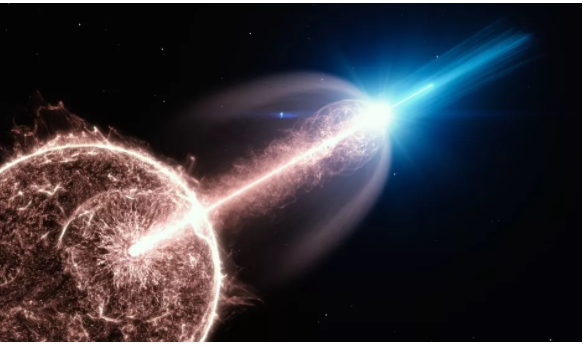Weird nearby gamma-ray burst defies expectations

A team of scientists has gotten their best look yet at a gamma-ray burst, the most dramatic type of explosion in the universe.
Astronomers think some of these explosions occur when a massive star — five or 10 times the mass of our sun — detonates, abruptly becoming a black hole. Gamma-ray bursts may also occur when two superdense stellar corpses called neutron stars collide, often forming a black hole. And conveniently, a gamma-ray burst that scientists watched during a few nights in 2019 likely occurred only about 1 billion light-years away from Earth, relatively close by for these dramatic events.
“We were really sitting in the front row when this gamma-ray burst happened,” Andrew Taylor, a physicist at the Deutsches Elektronen-Synchrotron (German Electron Synchrotron, or DESY) and co-author on the new paper, said in a statement. “We could observe the afterglow for several days and to unprecedented gamma-ray energies.”
Related: Record breaking gamma-ray burst captured by Fermi
Click here for more Space.com videos…
CLOSE
Two NASA space-based observatories, Fermi and Swift, first detected the event, which is known as GRB 190829A because it was detected on Aug. 29, 2019. The fireworks came from the direction of the constellation Eridanus, a large swath of sky in the Southern Hemisphere.
When the scientists behind the new research heard about the gamma-ray burst detection, they mobilized a set of five gamma-ray telescopes in Namibia, called the High Energy Stereoscopic System (HESS). Over three nights, the telescopes observed the explosion for a total of 13 hours, in an attempt to understand what took place.
An artist’s depiction of very-high-energy photons from a gamma-ray burst entering Earth’s atmosphere and being detected by the High Energy Stereoscopic System in Namibia.
An artist’s depiction of very-high-energy photons from a gamma-ray burst entering Earth’s atmosphere and being detected by the High Energy Stereoscopic System in Namibia. (Image credit: DESY, Science Communication Lab)
With those observations, the scientists could analyze much higher-energy photons than is possible in more distant gamma-ray bursts.
“This is what’s so exceptional about this gamma-ray burst,” Edna Ruiz-Velasco, an astrophysicist at the Max Planck Institute for Nuclear Physics in Heidelberg and co-author on the new research, said in the same statement. “It happened in our cosmic backyard, where the very-high-energy photons were not absorbed in collisions with background light on their way to Earth, as happens over larger distances in the cosmos.”
An artist’s depiction of NASA’s Swift satellite detecting X-rays from a gamma-ray burst.
An artist’s depiction of NASA’s Swift satellite detecting X-rays from a gamma-ray burst. (Image credit: DESY, Science Communication Lab)
During those analyses, the team noticed that the patterns of X-rays and very high-energy gamma-rays matched — something scientists wouldn’t expect, since they believe different phenomena cause the two different types of radiation.
But so far, scientists have only observed four of these bright explosions from the surface of Earth, so they’re hoping that new instruments and additional observations give them more insight into the details of gamma-ray bursts.
The research is described in a paper published June 3 in the journal Science.



 Creators of mankind
Creators of mankind Description of “Tall white aliens”
Description of “Tall white aliens” Where they came from?
Where they came from? About hostile civilizations
About hostile civilizations The war for the Earth
The war for the Earth “Tall white aliens” about eternal life
“Tall white aliens” about eternal life Video: “Nordic aliens”
Video: “Nordic aliens” Aliens
Aliens Alien encounters
Alien encounters The aliens base
The aliens base UFO
UFO Technology UFO
Technology UFO Underground civilization
Underground civilization Ancient alien artifacts
Ancient alien artifacts Military and UFO
Military and UFO Mysteries and hypotheses
Mysteries and hypotheses Scientific facts
Scientific facts


















